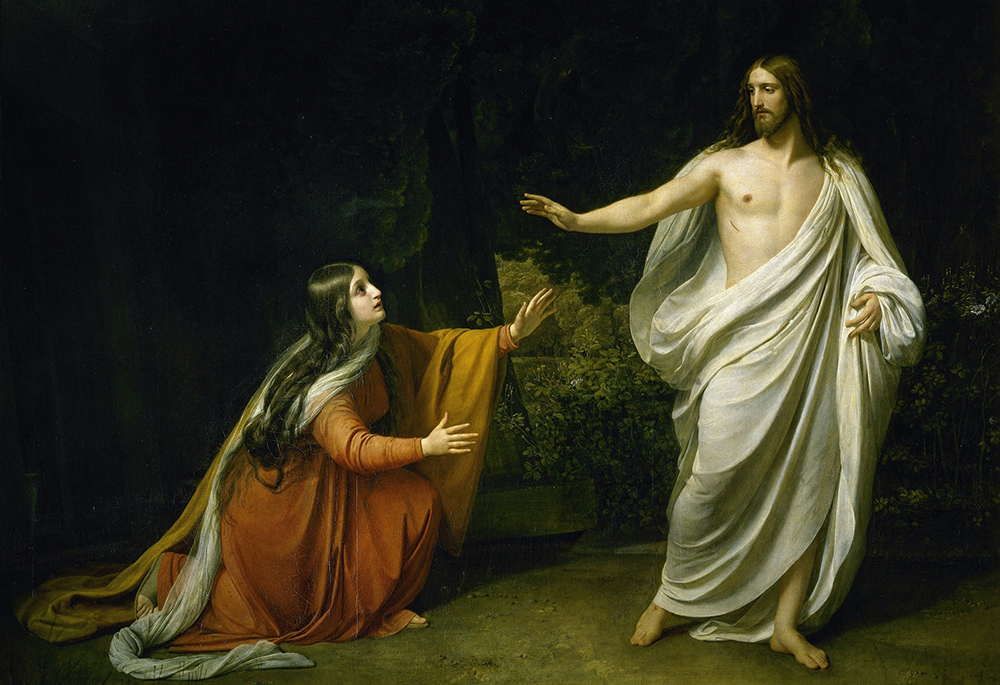
"Christ's Appearance to Mary Magdalene after the Resurrection," 1835, by painter Alexander Andreyevich Ivanov (Artvee)
How easy it is to say, "I know" someone. Yet, the more we know one another, the more we realize that human beings are ever-unfolding mysteries. So too with our faith. Each Sunday, we recite the profession of faith as if we really understood the words we are saying. On occasion, we even pay attention to them. Today, we hear Peter proclaim a creed describing the life, death and resurrection of Jesus. Peter was addressing Cornelius and his household, gentile people who were already following God's Spirit, ready to go where the Spirit would lead.
By telling the story of Cornelius about halfway through the Acts of the Apostles, Luke implies that Resurrection faith is not a one-time event, but a process. This realization helps us as we read John's multilayered account of "the first day."
John opens this story as the very beginning of the new creation: "On the first day of the week … while it was still dark." This description awakens tremendous admiration for Mary of Magdala as someone who could face the darkness and chaos, if not with hope, at least ready to honor and lament what had been. Unlike the disciples who had vanished from the public eye, she was willing to confront the void in public.
Then the void exploded into an unintelligible chasm: the tomb had been disturbed, the realm of death had been disrupted. The only possible explanation — someone had stolen the body. There was nothing more to do than to search for her friends who had gone into hiding. She announced the unthinkable truth as she understood it: "They have taken the Lord from the tomb, and we don't know where they have laid him." ("Laid" is a literal translation for "put.") When Peter and the other disciple followed Mary's lead and went to the tomb, the scene awaiting them looked nothing like a grave robbery. Who would steal a body and first remove the burial cloths? All of this to hint that Jesus' death was nothing like the death they understood.
Today's Gospel ends enigmatically. On the one hand, the Gospel writer tells us that the other disciple "saw and believed." On the other hand, the last thing we hear is that, "They did not yet understand the Scripture that he had to rise from the dead." When we ask, "which was it?" perhaps the best answer is "both."
The first time Jesus speaks in John's Gospel, he asks, "What are you seeking?" When dumbfounded disciples reply that they wish to know where he dwells, he responds, "Come and see." Through the entire Gospel, disciples try to understand who Jesus is; although they continually miss the mark, they remain with him and gradually grow in their knowledge. On the first day, after seeing all their hopes dashed, the disciples were confronted with the mystery. The very best they could do was believe in mystery, open themselves to hope that life was not what they thought it was after the Crucifixion. They believed even while they did not understand.
Advertisement
We would expect a better story for the principal liturgy on Easter Sunday. But that was the work of the Easter Vigil, the most exquisite of liturgical pageants that takes us through salvation history from creation to Christ's resurrection. Last night we heard the announcement, today we begin the joyful pilgrimage of the Easter season that moves us bit by bit, not only into believing, but into understanding better what this feast means for our lives.
Perhaps one exercise to celebrate Easter Sunday would be to listen to a musical rendition of today's sequence, an ancient hymn of praise that invites Mary of Magdala to tell the story from her experience. If you listen to it in Latin, you might first glance at the translation of the sequence, but then let the music carry you into appreciation of beauty that you cannot fully grasp. That is a preparation for the next step.
In an era before YouTube and Renaissance music, St. Paul encouraged the Colossians to let Easter faith permeate them and their outlook. Today, Paul invites us to allow faith in the risen Lord orient our lives. His call to "seek what is above" is not an appeal to abandon this life, but to believe that Christ and his resurrection have revealed that everything is oriented to union with God. That's the mystery we know and try to understand.
Most of us would say that we know what Easter signifies. Today's liturgy invites us to a bit more humility about God's ever-new creation. Today, let us join Mary and the disciples who believed so firmly that they could accept the fact that they did not understand. Remember, the Easter celebration that begins today is 50 days long.
